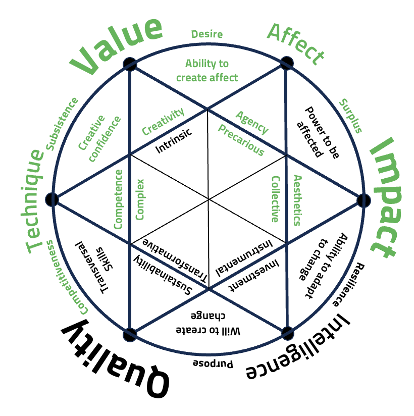
Societies are currently facing a plethora of challenges, yet they are becoming increasingly fragmented. The arts are confronted with hopelessly outdated expectations of making sense and providing an understanding of the world. At the same time, they are expected to produce a wide range of new sensibilities.
It is key to acknowledge that these fundamental issues cannot be resolved merely by demonstrating good intentions, raising the awareness of others and calling them to change behaviour. Instead, underestimating the severity of today’s societal challenges, addressing them with conventional methodologies and based on the data of the past will only serve to exacerbate existing misunderstandings. However, these issues have become pivotal in the context of the triple transition: climate, digital, and social.
These three dimensions of the current societal transformations and transitions do not only question the very idea of creativity as such, but have already generated radically new divisions of creative labour that are entirely different to the still predominant opinions and ideas about a creative production that is obsessed with a creative self.
There is an urgency to rethink the role of art and culture in society. Latest with the advent of collective intelligences such as AI/ML it has become evident that the division between the fields of reality, representation and creative subjectivity, has become obsolete. Furthermore, it also requires acknowledging intelligence of a different kind. To grasp the complex interactions and overlaps between machinic assemblages and collective assemblages of enunciation points to the need to question inherited notions of creativity.
Rather than claiming the role as the proprietor of creative work, individual authorship is the result of a collective production that involves a multiplicity of human and non-human agencies.
The climate crisis and the processes of transition resulting from it, present this challenge in a new and much sharper light: How can the collective threat of human life on the planet pave the way for collective agencies rather than responses on personal or individual level? Furthermore, what could be the role of art and culture, heritage and creativity to push the pace of transitions that are powered by collective intelligences and collective agencies rather than narcissistic modes of individual authorship and ownership?
Specific challenges for PACESETTERS main target groups:
- For artists and creatives: Developing techniques to build competence and creative confidence driven by desire for creativity in the tensions between a creative self and collective agency
- For research: Navigating instrumental relationships by (self-)critically reflect one’s own position within new divisions of creative labour and analyse the surplus generated from them
- For policymakers: Acknowledging the value and impact of new divisions of creative labour in terms of increased competitiveness
- For finance and investment: Systematically exploring new mechanisms of building trust and confidence through ventures that are built on the ability to create affect, collective ownership and creative subsistence.
